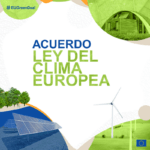The new Guidelines provide the framework for public authorities to support the European Green Deal objectives efficiently and with minimum distortions of competition. The new Guidelines propose:
Broaden the categories of investments and technologies that Member States can support;Increase flexibility and streamline the existing rules;Introduce safeguards; Ensure coherence with the relevant EU legislation and policies.
How will the CEEAG interact with the General Block Exemption Regulation (GBER)?
While the CEEAG include some specific rules for small projects, they are generally designed to cover also larger aid measures. They operate alongside the General Block Exemption Regulation (GBER), which provides scope for certain smaller schemes to be implemented without prior approval by the Commission.

Directive (EU) 2018/2001 of the European Parliament and of the Council of 11 December 2018
|
How will the CEEAG contribute to the Green Deal / Fit for 55 package?
The CEEAG will help Member States meet the European Green Deal objectives, at the least possible cost for taxpayers and without unduly distorting competition. To this end, the Guidelines are aligned with relevant EU legislation and policies in the environmental and energy fields. In particular:
- The CEEAG adopt a technology neutral approach to all the technologies that can contribute to the reduction or removal of greenhouse gases, including renewable energy and energy efficiency.
- To facilitate the implementation of the Renovation Wave, the CEEAG include for the first time a dedicated section on the energy and environmental performance of buildings.
- he CEEAG provide clear rules for support to clean mobility, in line with the Clean Mobility Package.
- The CEEAG provide for a broad coverage of and clearer rules for aid to increase the level of resource efficiency of companies, and allow for the development of a more circular economy, in line with the Circular Economy Action Plan.
- In line with the objectives of the Biodiversity Strategy, the CEEAG provide clear rules for Member States to support the protection and restoration of biodiversity, the rehabilitation of natural ecosystems and the implementation of nature-based solutions.

European Green Deal: transformation of EU economy and society to meet climate ambitions
|
What is the link between the CEEAG and Taxonomy?
The CEEAG and the EU Taxonomy are both important pillars of the European Green Deal, fulfilling different but complementary roles:
- The CEEAG are the EU rulebook for public support in the energy and environmental sectors.
- The EU Taxonomy is a tool developed to enable private investors to re-orient investments towards more sustainable technologies and businesses. It will help make the EU a global leader in setting standards for sustainable finance.
How can the CEEAG contribute to tackling high energy prices?
The current high energy prices in Europe are mostly the result of global supply and demand patterns in the natural gas market, driven in part by the global economic recovery.
On 13 October, the Commission adopted a Communication on “tackling rising energy prices while delivering the green transition” that describes the main tools for Member States to tackle this challenge, and how the Commission can support them in this respect
The best way to reduce energy costs in the medium and long term is to reduce the EU’s dependence on fossil fuel imports, and thus to accelerate the energy transition towards an energy efficient electricity system, based on renewable energy.
Biodiversity strategy for 2030
How do the CEEAG foster the development of renewable energy communities and other smaller actors?
Renewable energy communities (REC) and other small actors play an important role in the achievement of the European Green Deal objectives
SMEs and small mid-caps can also benefit from aid when they provide energy performance improvement measures under energy performance contracts, either for buildings or industrial activities. Furthermore, aid intensities can be increased by 20 percentage points for small undertakings or by 10 percentage points for medium-sized undertakings for a number of aid categories such as aid for energy performance improvements in buildings, aid for the acquisition of zero-emission vehicles and the deployment of recharging and refuelling infrastructure, aid for resources efficiency, aid for the prevention or the reduction of pollution other than from greenhouse gases, and for studies or consultancy services on matters relating to climate, environmental protection and energy.
Why is nuclear energy not covered by the Guidelines?
The CEEAG follow the same line as the previous guidelines (the 2014 Energy and Environmental Aid Guidelines, EEAG) and therefore do not apply to nuclear energy. This is because support for nuclear energy generally concerns a limited number of very large projects, is particularly sensitive from a security perspective, legally needs to take account particularly of the EURATOM treaty, and thus requires a case-by-case assessment.

Council Regulation (Euratom) 2021/948 of 27 May 2021 |
Do the CEEAG cover aid for the production of products contributing to the green transition (e.g. zero-emission vehicles, electrolysers, etc.)?
The CEEAG do not cover aid for the manufacturing of environmentally friendly products, machines or means of transport.
Aiding the producer or manufacturer of the environmentally friendly product does not bring about an environmental benefit in itself; such benefit materialises only if and when such products substitute more polluting alternatives.
Can fossil fuels be supported under the CEEAG?
The CEEAG ensure coherence with the Union climate targets by contributing to phasing out the possibility of subsidies for fossil fuels. For the most polluting fossil fuels, the guidelines foresee that a positive assessment by the Commission under State aid rules is unlikely in light of their negative environmental effects
How will the Commission assess whether fossil fuel investments are compatible with the 2030 and 2050 climate targets?
The Commission may require commitments to ensure the ‘lock in’ of fossil fuels is avoided and fossil fuel installations are compatible with the 2030 and 2050 targets.
The CEEAG include safeguards, such as the requirement for public consultation and quantification of the CO2 abatement cost. Why are they necessary?
By ensuring transparency and inclusiveness, these safeguards contribute to ensuring value for money.
Some of the safeguards – for example the public consultation requirement – are applicable only for schemes or projects that exceed a certain budget, to avoid excessive burdens for smaller aid applicants or straightforward measures.
What is the ‘funding gap’?
The funding gap corresponds to the difference between the costs and revenues of an activity that contributes to the achievement of higher climate, energy or environmental standards compared to the costs and revenues of a similar, less environmentally friendly activity that would be carried out in the absence of aid. Therefore, the funding gap identifies the minimum aid necessary to incentivise the aided activity.
There are a number of specific sections and areas of the Guidelines on certain topics such as:
- Renewable energy sources
- Energy and environmental performance of buildings
- Clean mobility
- Resource efficiency
- Security of electricity supply
All the information:
European Commission- Guidelines on State aid for climate, environmental protection and energy 2022







Leave a Reply